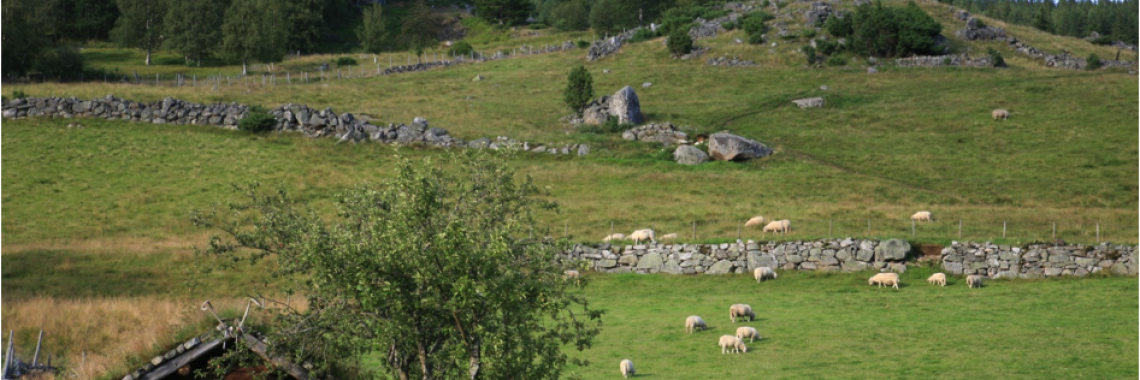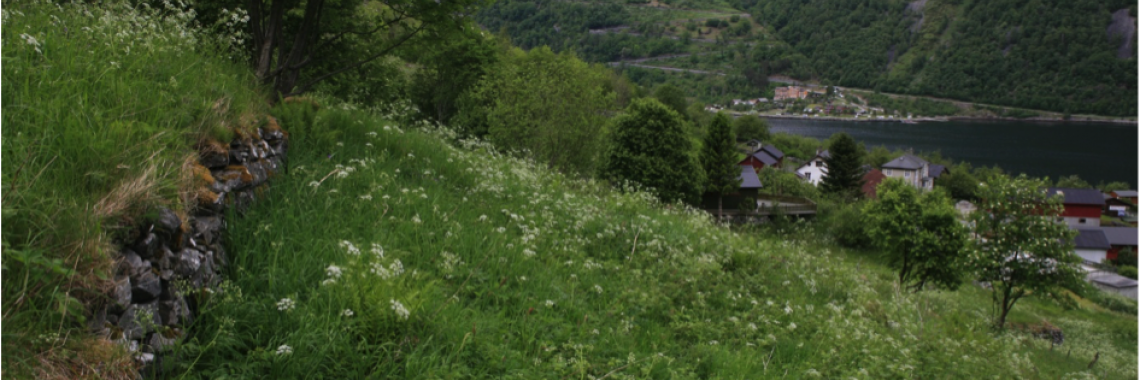Terraced landscapes in Norway
28.09.2017, by Bénédicte Gaillard
Research: NIBIO, Sebastian Eiter, Oskar Puschmann et al; upload: Bénédicte Gaillard. The entries are still in process, the e-atlas is still under development
Terraces have been a very common feature in parts of the Norwegian agricultural landscape for centuries. The general Norwegian term for terrace is terrasse. However, the term is not only used for intentionally created terraces, but also for terraces that have ‘appeared’ through long-term tillage, namely ploughing along slopes, which has resulted in erosion in the upper and accumulation (åkerreiner) in the lower part of arable fields. This type of terrace appearance is considered to be as old as the introduction of the related tools into farming practice. Its effect has often been tried to be counteracted through manual transport of soil from the lower back to the upper part of the farmland, unless the different parts of the land had different owners
Grue, U.D. (Ed.) [1993]. Ta vare på gamle hager. Statens fagtjeneste for landbruket, [Oslo] / Hageselskapet, [Ås].
Hauge, L. 2000. Det vestnorske kulturlandskapet: Særtrekk, problem og utfordringar. in: Ådland, E, Austad, I. & Indrelid, S. (Eds.) Det vestnorske kulturlandskapet: Rapport frå seminar i Sogndal 11.-12. oktober 1999, pp. 5–12. Bergen Museums skrifter 6, Bergen Museum, Universitetet i ebrgen and Høgskulen i Sogn og Fjordane, Bergen and Sogndal
Hope, K. 1994. Havrå – ein kulturlandskapsanalyse. Kulturlandskapssenteret, Kulturetaten, Hordaland fylkeskommune, FOK-NAV.
Jacobsen, H. & Follum, J.-R. 2008. Kulturminner i Norge. Vigmostad & Bjørke, Bergen.
Norderhaug, A. & Losvik, M.H. 1999. Kap. 16: Åker. In: Norderhaug, A., Austad, I., Hauge, L., Kvamme, M. (Eds.): Skjøtselsboka for kulturlandskap og gamle norske kulturmarker, pp. 183–192. Landbruksforlaget, Oslo.
Puschmann, O., Reid, S.J. & Lågbu, R. 2008. Evaluering av RMP-2006: Kulturlandskapstiltak. Oppdragsrapport fra Skog og landskap 02/2008. Norsk institutt for skog og landskap, Ås.
Salvesen, H. 1979. Tverrvitenskapelige metoder med særlig anvendelse på bosetningsundersøkelser. In: Fladby, R. & Sandnes, J. (Eds.) På leiting etter den eldste garden: Nye metoder i studie av tidlig norsk bosettingshistorie, pp. 151–163. Universitetsforlaget, Oslo.
Skre, B.G. 1994. Havråboka: Soga om ein gammal gard på Osterøy. Stiftinga Havråtunet, Osterøy.
Solbu, I. 1975. Kulturminner i midtre Vest-Agder. NLVF-prosjekt 17013.01, Arbeidsrapport 8. Institutt for hagekunst, Norges landbrukshøgskole, Ås.
Stokstad, G. & Puschmann, O. 2011. Status og utvikling i jordbrukets kulturlandskap: Hordaland, Sogn og Fjordane, Møre og Romsdal, Sør-Trøndelag og Nord-Trøndelag. Rapport fra Skog og landskap 13/2011. Norsk institutt for skog og landskap, Ås.
Stokstad, G. & Puschmann, O. 2012. Status og utvikling i jordbrukets kulturlandskap: Buskerud, Telemark, Aust-Agder, Vest-Agder og Rogaland. Rapport fra Skog og landskap 13/2012. Norsk institutt for skog og landskap, Ås.
Visted, K. & Stigum, H. 1951. Vår gamle bondekultur. Bind I. J. W. Cappelens forlag, Oslo.
Constructed terraces are usually defined and talked about from the perspective of the stone walls that have been set up to create them: bakkemurer, terrassemurer, in local dialect also, for example, åkerlad or bakkelad. Terraces have been built on arable land, meadows and pasture , to prevent farmland from downhill erosion and to increase its usability through flattening. At the same time terrace walls were a way of using stones that had been cleared from the farmland. Terraces are common on farms at steeper slopes, for example in fjord valleys of Western and Central Norway and in upper valleys of eastern Norway, whereas they are basically absent below the upper limit of marine deposits in Eastern Norway. Many terrace walls are considered to be built after the reformation of 1537, which means they are not automatically protected as cultural heritage by law. The construction period was probably finished by the mid-20th century at the latest, i.e. right before larger-scale mechanization or industrialisation of agriculture. As terraces are relatively small and not suitable for farming with larger machinery, basically all terraced farmland is now used as pasture or abandoned. Terrace walls are recognized as part of the agricultural landscape heritage, and financial support to maintenance work has become part of several regional agri-environmental subsidy schemes.










